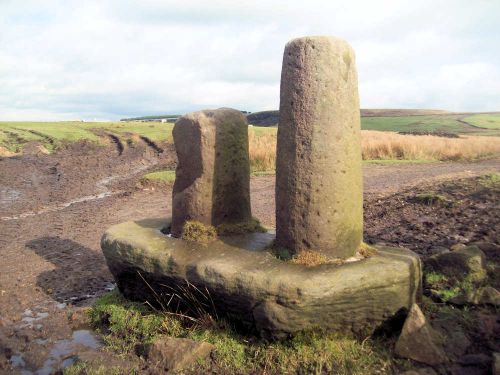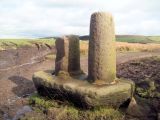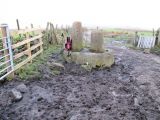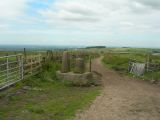Robin Hood's Picking Rods (Chisworth)

By Henrik Thiil Nielsen, 2016-06-26. Revised by Henrik Thiil Nielsen, 2018-10-27.
'Robin Hood's Picking Rods' is the popular name of two stone columns standing side by side in a stone socket, the tallest column being about 2 metres high. They are located on the outskirts of Ludworth Moor c. 3.5 km WSW of Charlesworth. Archaeologists believe the two pillars were originally "almost certainly the lower parts of two Saxon crosses" dating from the 10th century or earlier. They probably marked the boundary between ecclesiastical divisions or Danish and English Districts. However, it has also been argued that they were erected in the Norman period.[1] Various other suggestions have been made as to their origin. Carl Rogerson discusses several such hypotheses, some less likely than others, including a myth of origin intended to explain the name 'Robin Hood's Picking Rods': the columns were used when bending and stringing bows, i.e. they were essentially a tool for making longbows.[2] This would seem to be a rationalization of the "Legend" that "Robin Hood used the column or columns 'to bend his bow on'".[3] In the absence of any convincing evidence to the contrary, let us stick with the archaeologists and Anglo-Saxon crosses. As Carlson notes, the stones stood at the Derbyshire–Cheshire border (they are now at the Derbyshire–Greater Manchester border). Whatever the signifance and function of the original stone crosses, Robin Hood's Picking Rods thus served to mark the county boundary during the medieval to modern period.
While the stones themselves thus probably date from the early middle ages, the name 'Robin Hood's Picking Rods' is first recorded at a relatively late date, for it is first found on an 1842 O.S. map of the area.[4] In the 17th century, Robin Hood's Picking Rods were known as the Maiden Stones.[5] Apparently this monument is also known as 'Robin Hood's Stumps' and the 'Druid Stones'.[6] Kenneth Cameron notes in one of the English Place-Name Society volumes on Derbyshire that all Robin Hood-related place-names in Derbyshire are first recorded at a late date.[7]
Allusions
Gazetteers
- Dobson, R. B., ed.; Taylor, J., ed. Rymes of Robyn Hood: an Introduction to the English Outlaw (London, 1976), p. 297, s.n. 'Robin Hood's Picking Rods'.
Sources
- Cameron, Kenneth. The Place-Names of Derbyshire (English Place-Name Society, vols. XXVII-XXIX) (Cambridge, 1959), pt. I (vol. XXVII), p. 154. and see p. lxiii; pt. III (vol. XXIX), p. 760
- Tudor, Thomas L., compil. 'Minor Monuments and Lesser Antiquities of Derbyshire, 1934: on or near the Highways, Byways, Disused Roads and Ancient Boundaries, First List', Derbyshire Archaeological Journal, vol. 55 (1934), pp. 64-76; see p. 66, item No. 21.
Maps
- 6" O.S. map Derbyshire V.NE (1882; surveyed 1879)
- 6" O.S. map Derbyshire V (1899; surveyed 1896)
- 1" O.S. map sheet 99 - (1896)
- 6" O.S. map Derbyshire V.NE (1923; surveyed 1919)
- 6" O.S. map Derbyshire V (1924; surveyed 1917-19)
Discussion
- Carl's Cam: Robin Hood's Picking Rods, Charlesworth, Derbyshire (by Carl Rogerson)
- Collingwood, W. G. 'The Brailsford Cross', Journal of the Derbyshire Archaeological and Natural History Society, vol. 45 (1923), pp. 1-13; see p. 10
- Lawrance, H 1924a
- Megalithic Portal: Robin Hood's Picking Rods – Ancient Cross in England in Derbyshire (by user 'Sunny100')
- Pastscape: Robin Hoods Picking Rods
- Smith, G Le Blanc. 'Some Pre-Roman Crosses in Staffordshire', The Reliquary, New Series, vol. XII (1906), pp. 229-46; see pp. 237, 240.
Photos
- Geograph.co.uk: Robin Hood's Picking Rods
- Megalithic Portal: Robin Hood's Picking Rods – Ancient Cross in England in Derbyshire.
Brief mention
Notes
- ↑ See Pastscape: Robin Hoods Picking Rods and sources referred to there. Also see Dobson, R. B., ed.; Taylor, J., ed. Rymes of Robyn Hood: an Introduction to the English Outlaw (London, 1976), p. 297, s.n. 'Robin Hood's Picking Rods'.
- ↑ See Carl's Cam: Robin Hood's Picking Rods, Charlesworth, Derbyshire.
- ↑ Megalithic Portal: Robin Hood's Picking Rods – Ancient Cross in England in Derbyshire.
- ↑ Cameron, Kenneth. The Place-Names of Derbyshire (English Place-Name Society, vols. XXVII-XXIX) (Cambridge, 1959), pt. I, p. 154, and see p. lxiii for expanded source reference; Dobson, R. B., ed.; Taylor, J., ed. Rymes of Robyn Hood: an Introduction to the English Outlaw (London, 1976), p. 297, s.n. 'Robin Hood's Picking Rods'.
- ↑ Pastscape: Robin Hoods Picking Rods; Tudor, Thomas L., compil. 'Minor Monuments and Lesser Antiquities of Derbyshire, 1934: on or near the Highways, Byways, Disused Roads and Ancient Boundaries, First List', Derbyshire Archaeological Journal, vol. 55 (1934), pp. 64-76; see p. 66, item No. 21.
- ↑ Megalithic Portal: Robin Hood's Picking Rods – Ancient Cross in England in Derbyshire (by user 'Sunny100')
- ↑ Cameron, Kenneth. The Place-Names of Derbyshire (English Place-Name Society, vols. XXVII-XXIX) (Cambridge, 1959), pt. III (vol. XXIX), p. 760.
Robin Hood's Picking Rods / Jonathan Clitheroe, Creative Commons via Geograph.
Robin Hood's Picking Rods: the immediate surroundings are not (always) picturesque / Rude Health, Creative Commons via Geograph.
Robin Hood's Picking Rods / John Topping, Creative Commons via Geograph.



